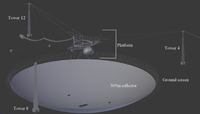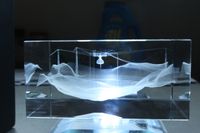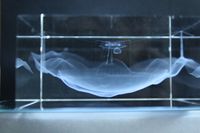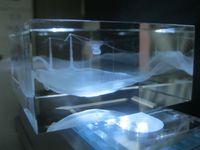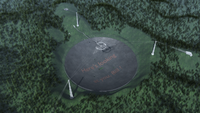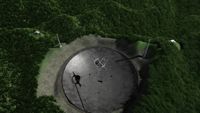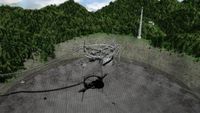Arecibo
I lived and worked at Arecibo from ~March 2011 – August 2013 or thereabouts, when it was at the very height of its powers. At 305m in diameter, the William E. Gordon telescope was not only then the largest but also one of the most iconic of the world's radio telescopes. Though it starred in Goldeneye and Contact, there wasn't an accurate 3D computer model of the telescope to play with. So my boss decreed that this had to change, mostly to create a laser-etched glass cube. A project for which I have only myself to blame, since I had such a cube (containing hydrogen data from the Virgo Cluster) sitting on my desk...
Modelling the telescope was a somewhat arduous process, because it involved a lot more physical exercise than is normally expected for computer modelling. True, I had the official telescope schematics to hand (both paper and electronic copies). But the telescope structure is massively complex, and there's really only so much you can get from schematics and even photographs. From two-dimensional drawings it's nigh-on impossible to work out where all the cables go. But with a great deal of site walking (not so easy in the heat and humidity of the tropics), the schematics, and terrain data from the USGS, I was able to put together a basic model in about a week or so. Not one you could do engineering studies with, but good enough that all the basics are there.
This model was sent off to Crystal Proteins, the same company that made the Virgo glass cube for me. They converted the surface meshes into a point cloud :
And after checking that this looked satisfactory, they produced this lovely physical glass cube, about 10 cm on a side. My boss ordered them in bulk and they were sold at the visitor centre. Presumably if you ask Crystal Proteins, they'll still be able to sell you one directly.
Later, naturally I modified this into a much more detailed, fully textured model. One of the first uses for this was for the background visual at Arecibo's 50th anniversary celebrations, which I was sadly not present for. This was inspired by the Game of Thrones title sequence :
Later I added many more details, both because I just wanted to but also with the goal of creating a virtual reality tour of the site. Doing Arecibo justice is a challenge of which I will claim no more than partial success. The telescope itself is fantastically complex, necessitating that I omitted a lot of details just for the sake of my own sanity (one of the main simplifications being the girders, which here are all simple cuboids but in reality each had a lattice-like truss structure). Not only that, but I couldn't find terrain detail at anything better than 30 m resolution, which isn't great. And the site needs to be large enough to show the full gargantuan scale of it; the telescope itself is already enormous, so its surroundings need to be even larger. Showing dense vegetation on that scale is not easy.
Nevertheless, in the end I got something, however imperfect.
With this I made a simple flythrough animation just to show off the improved model. It's got a lot of artifacts, partly because vegetation is just innately difficult to render, and partly because Blender has (or had) some bugs with setting the image texture coordinates – hence the ground appears to flicker sometimes.
The ideal thing I'd like to do with the model is to have an interactive web-based tour. I want people to be able to explore the site and learn about this amazing telescope in a way that only a few of us were lucky enough to do in real life. This has been partially realised. Mat Allen, another Cardiff alumni, made this interactive web page where you can click on different parts of the site and look around, hearing different narrations about each section. What you can't do, unfortunately, is move around like in a game; you're confined to a set of fixed positions.
But in VR... you can do everything I wanted and more. There's this crappy video I made as an early test when I didn't have a VR-capable PC, but it's horrible. I just could not get the video quality to be sufficient. I suppose it's better than nothing but the compression is hideous. Eventually, though, I got a high-end laptop, learned how to export Blender models into Steam VR environments, and came up with this :
Walk around the site and chuck things off the top ! See informative info panels everywhere ! What more could you want ? And if you have a VR headset capable of accessing Steam VR, you can try this for yourself here. It's been quite popular in open days when kids realise that one of the things they can throw off is a toilet.
Finally a couple of science renders. In the first movie you can see the image on the left, showing the radio continuum sky from the GALFACTS survey. On the right, as in the VR tour, you see the sky at 21 cm wavelengths from the GALFA-HI survey of atomic hydrogen in the Milky Way. Both of these use real Arecibo data.
